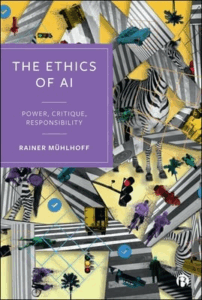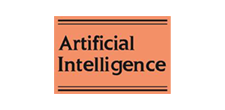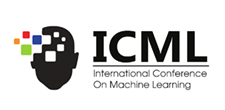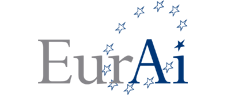
ΑΙhub.org
Better images of AI on book covers

By Better Images of AI Stewards
We’re often told not to judge a book by its cover. And yet, a cover is often the reason why a reader first picks up a book. A book’s cover design is the window into its story and the author’s intentions. For Better Images of AI, in the context of books about AI and technologies, it’s refreshing to see covers that go beyond unhelpful norms and stereotypes such as tropes of robots, glowing brains, and unnecessary (white) men in suits.
In this blog post, we share insights from Chrissi Nerantzi on the decisions behind the cover of the open-sourced book ‘Learning with AI’. We also reflect on the significance of book covers, highlighting some examples of covers that have featured “better images of AI” with reflections from our volunteer community.
‘Learning with AI’ – considerations behind the cover
‘Learning with AI’ is an open-source book from the University of Leeds. We spoke with Chrissi Nerantzi, part of the project team about their choice to use Ariyana Ahmad’s illustration ‘AI is Everywhere’ for the cover of the book.
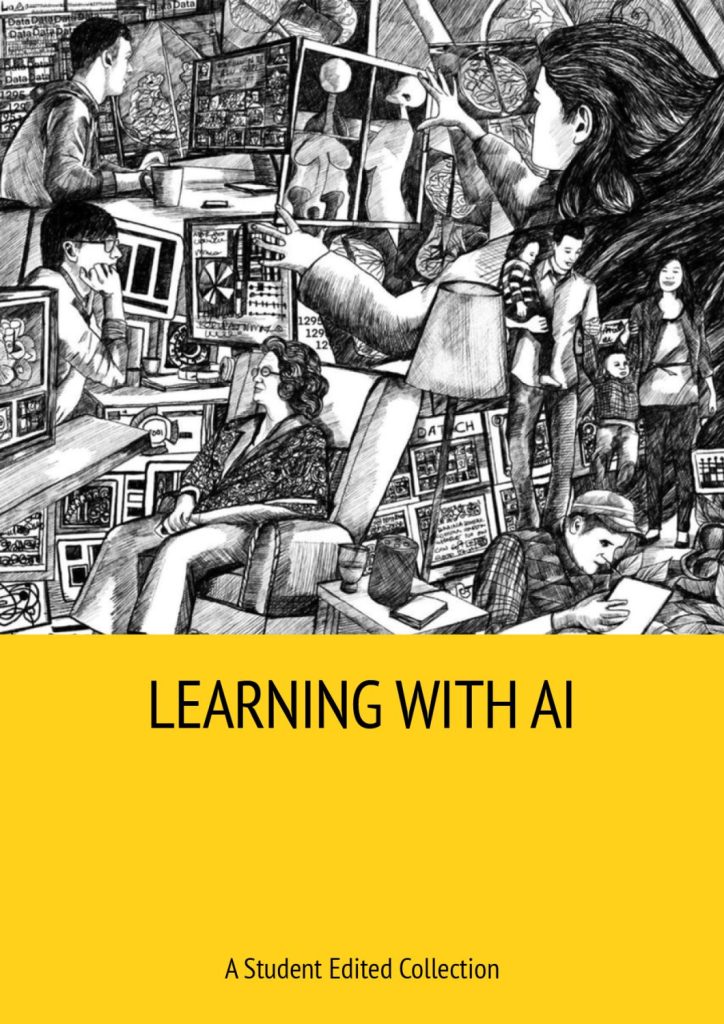 Learning With AI: A Student Edited Collection by the University of Leeds.
Learning With AI: A Student Edited Collection by the University of Leeds.
For the team, the choice of cover was about more than just visual aesthetic. It was about reflecting the collaborative and collective nature of the book itself. Initially the team were drawn to the idea of a collage since the team have used these for some of their other open books (see for example here). Collages can capture multiple perspectives, textures, and approaches, much like the student voices incorporated throughout the book.
Ahmad’s illustration, while not a collage, achieves a similar effect. Its black-and-white style depicts diverse scenes of AI’s impact, from data analysis to agriculture, reflecting the different contributions from students who write about the use of generative AI in their studies.
“I looked through the wonderful artwork from the Better Images of AI library and could see some of our collective thinking reflected in many of the visuals. I felt that using one of these for our book cover would be a perfect fit. We selected and agreed to use Ariyana Ahmad’s artwork “AI is everywhere” for our book cover.” – Chrissi Nerantzi
Another key factor was openness. The images in the Better Images of AI library are open-source, freely available under Creative Commons BY 4.0 (read more here). This mirrored the ethos of Learning with AI which is a living, collaborative resource developed by students, academics, and the public together. The open licensing allowed the book to embody its own values of collaboration, accessibility, and incremental learning.
“We routinely build on work by others, remix, reappropriate, and evolve it. We are inspired by what we see, experience, discuss, read and debate about, play and experiment with, our mistakes and failures, and use our imagination, ingenuity and resourcefulness to come up with new and exciting creations that can be experiences, processes and products that add value in some way. Creativity can’t happen without openness.” – Chrissi Nerantzi
The significance of book covers
Every author wants a cover that communicates both the passion behind their work and a sense of what the reader will discover inside. But as Anne Jordan and Mitch Goldstein write in the Stanford University Press blog, a good cover should also “reward the reader” by offering a touch of mystery, something that allows space for personal interpretation and grows in meaning as the text unfolds. By this, they mean that book covers should not be overly prescriptive about what the author intends to communicate, but actually, depth in an image enables readers to still resonate with the cover as their journey and experience through the book might change, challenge preconceptions and evolve with the narrative.
“A good book cover should also reward the reader – there should be a little bit of mystery to allow for personal interpretation, and enough depth in the image so the reader’s experience of the cover changes and grows as they make their way through the text.” – Anne Jordan and Mitch Goldstein
In ‘The Art of First Impressions’, Chip Kidd makes a similar point. Sometimes, clarity in visual communication is really important – for example, for street signs or instructions. But he argues, “mystery is an extremely powerful tool” when you want to grab attention and invite deeper engagement. In the context of AI, mystery can be particularly valuable, since oversimplified stereotypical imagery hinders the reader’s ability to reflect on the subject, reinforcing the illusion of pre-determined futures involving AI.
“You should be mysterious when you want to get people’s attention and hold it, when you want your audience to work harder.” – Chip Kidd
An example of this balance between clarity and mystery is the cover of Nick Srnicek’s book ‘Silicon Empires’ which uses GPU shot etched 5’ by Fritzchens Fritz from the Better Images of AI library. The image grounds the book in the material realities of AI, while also evoking a sense of wonder through its rainbow hues, a marked departure from the usual “deep blue sublime” that is usually embedded within stock images of AI.
Srnicek’s book explores the geopolitical economy of AI, so this cover aims to show how high-level strategic moves between governments and corporations have material impacts on the environment and the world that we live in. Srnicek could have chosen a stereotypical visual of AI (white anthropomorphised robot, human brain, or blue holograms), but in choosing an alternative image, it made it clear that this book was making a different statement about the development of AI. Even if readers might not immediately understand the cover of this book, this might be half the point to entice readers to investigate the book in order to decode it – relating to the idea of mystery which was explored above.
Another example of a book that has featured one of the images from our library is ‘The Ethics of AI: Power, Critique, Responsibility’ by Rainer Mühlhoff. This book serves as an accessible and critical interrogation of the effect of AI in society, with a focus on the interplay between AI and power. This book moves away from attempting to predict the ways in which technology could lead to existential risks and the end of humanity. Rather, The Ethics of AI is grounded in the ‘now’ – much like the Better Images of AI library! Mühlhoff considers the social-normative behaviours, power structures and other elements of society, based upon case-studies, to help people understand how a composite of personal responsibility, policy and an understanding of the risks present are vital to helping AI go well.“Artists and communicators are well aware of the power of images. They can inform, inspire, draw attention, or simply entertain. Images that are misleading or inaccurate are equally powerful, but with potentially damaging consequences: they can misinform, limit the imagination, or divert attention from pressing issues.” (Dihal and Duarte, 2023, 5)
The cover uses Anne Fehres, Luke Conroy and AI4Media’s image, ‘the Hidden Labour of Internet Browsing’. This image explores the hidden labour behind our everyday use of AI. The use of this image clearly works for Mühlhoff’s book, as it has the perfect mix between the ‘everyday’ and the hidden structures at play, these are embedded within the sliced and slanted crosswalks across the cover. Not only visually striking, this image also meets Goldstein’s assessment of what makes a good book cover, adding some mystery that will reward the reader as they read since the themes will become clearer the more they understand of Mühlhoff’s position.
Of course, the images in the library have not been created to cater for specific books in mind (though some have certainly been inspired by books!). Still, we are always happy to see them used in this way, especially by authors who may not have large budgets or the support of a major publishing house.
The covers of books about AI
Below, we showcase a selection of other book covers that use visuals of AI that challenge common tropes. Each example demonstrates how visual choices can reinforce the themes of a book and the author’s intentions. Thank you to some of our volunteer stewards for their collection and commentaries on these covers: Beckett LeClair, Laura Martinez, and Liam Palette.
Technology is Not Neutral: A Short Guide to Technology Ethics by Dr Stephanie Hare
 This 2022 book by Dr Stephanie Hare explores how we can create and deploy technologies to minimise harms and maximise benefits. It directly challenges notions of neutral, amoral and unquestionable tech, instead inviting us to consider how wider contexts feed into the ethicality of our use of technologies. The bold colour scheme immediately grabs the viewer’s attention. The provocative imagery of devil horns and a ‘watchful’ device conveys a core argument – that ethics are influenced by a technology’s very designers and users – in a remarkably simple way.
This 2022 book by Dr Stephanie Hare explores how we can create and deploy technologies to minimise harms and maximise benefits. It directly challenges notions of neutral, amoral and unquestionable tech, instead inviting us to consider how wider contexts feed into the ethicality of our use of technologies. The bold colour scheme immediately grabs the viewer’s attention. The provocative imagery of devil horns and a ‘watchful’ device conveys a core argument – that ethics are influenced by a technology’s very designers and users – in a remarkably simple way.
Human-Centred AI by Ben Shneiderman
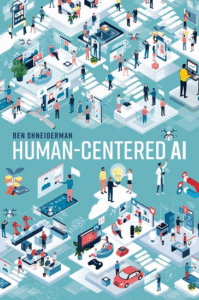 This book focuses on the opportunities presented by AI and how we might capitalise on them through human-centred approaches. Shneiderman writes specifically about his choice not to use a visual with a harmful AI trope like humanoid robots, based on his belief that AI will not possess human-like capabilities like “two-legged mobility, five-fingered dexterity, and dominance of voice interaction”. In deciding on what the cover of his book should include, Shneiderman developed guidelines on what he wanted: images of people, diverse people, expressive human features, technology connecting and empowering people, and natural world representations.
This book focuses on the opportunities presented by AI and how we might capitalise on them through human-centred approaches. Shneiderman writes specifically about his choice not to use a visual with a harmful AI trope like humanoid robots, based on his belief that AI will not possess human-like capabilities like “two-legged mobility, five-fingered dexterity, and dominance of voice interaction”. In deciding on what the cover of his book should include, Shneiderman developed guidelines on what he wanted: images of people, diverse people, expressive human features, technology connecting and empowering people, and natural world representations.
Communicative AI by Mark Coeckelbergh and David J. Gunkel
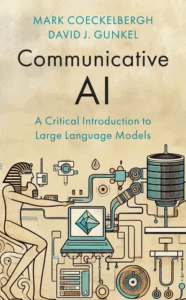 ‘Communicative AI’ takes a critical introduction to LLMs inspired by philosophy, history of ideas, linguistics, and communication theory. Through exploring LLMs in relation to these disciplines, the authors confront longstanding debates about language, consciousness, truth, authorship, and writing. The choice of book cover is especially interesting and could be read as an homage to Plato’s myth of Theuth and Thamus from the Phaedrus for those familiar with Ancient Greek philosophy. Here, Socrates questions the invention of writing, which he argues, in comparison to dialectic discourse, weakens memory and offers the appearance of wisdom without true understanding.
‘Communicative AI’ takes a critical introduction to LLMs inspired by philosophy, history of ideas, linguistics, and communication theory. Through exploring LLMs in relation to these disciplines, the authors confront longstanding debates about language, consciousness, truth, authorship, and writing. The choice of book cover is especially interesting and could be read as an homage to Plato’s myth of Theuth and Thamus from the Phaedrus for those familiar with Ancient Greek philosophy. Here, Socrates questions the invention of writing, which he argues, in comparison to dialectic discourse, weakens memory and offers the appearance of wisdom without true understanding.
In the context of LLMs and the critical approach that Coeckelbergh and Gunkel take in their book, this historically inspired cover is fitting to modern day debates about whether LLMs are weakening our own critical thinking abilities and limiting our ability to achieve genuine understanding. The use of a historical cover adds to a sense of mystery and appeal since AI is usually represented in ways that try to present it as “new”, “innovative”, and “magical” – this book cover takes us back to debates we’ve long had throughout history, stretching back to Socrates’ questioning of the invention of writing over 2000 years ago.
Feeding the Machine by James Muldoon, Mark Graham and Callum Cant
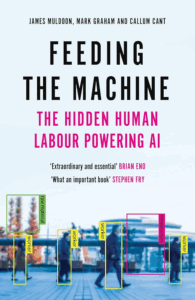 Based on years of fieldwork research, and through the story of seven workers around the world, Feeding the Machine, by James Muldoon, Mark Graham and Callum Cant, shows the extractive ways in which AI system are powered, mostly by humans workforce, resulting also in the concentration of power of tech company and elites. The authors call on us to demand a fairer digital future:
Based on years of fieldwork research, and through the story of seven workers around the world, Feeding the Machine, by James Muldoon, Mark Graham and Callum Cant, shows the extractive ways in which AI system are powered, mostly by humans workforce, resulting also in the concentration of power of tech company and elites. The authors call on us to demand a fairer digital future:
“If this book could be distilled to a single message is that we, human beings, are the often-hidden force that powers AI – both physically with our labour but also intellectually through AI ingesting and synthesising our collective intelligence” (p. 220).
The cover image from Shutterstock is an excellent choice that engages with the content. It reflects the process of AI data labelling and AI-generated annotation. It could depict the process of manually assigning labels or categories, which often involves precarious global workforce. It could also represent the tags already added to a dataset to train machine learning models in image recognition, thereby demonstrating how public spaces are repeatedly labelled and surveilled. It brings together the process and the results. You have three categories: raw material (trees), workers (ironically, most of us already fall into this category, or will do. Are we really just a workforce?), and infrastructure (pretty general to fit in?).
Public Data Cultures by Jonathan W.Y. Gray
 ‘Public Data Cultures’ explores the practices and cultures of how data is made public in the age of the Internet. Typically, the language is saturated with extractive and industrial metaphors: “data mining”, “data harvesting”, “data pipelines”, and the common phrase, “data is the new oil”. Gray’s book aims to centre the idea of public data as a networked cultural material through a more critical and creative interrogation of what it means to make data public.
‘Public Data Cultures’ explores the practices and cultures of how data is made public in the age of the Internet. Typically, the language is saturated with extractive and industrial metaphors: “data mining”, “data harvesting”, “data pipelines”, and the common phrase, “data is the new oil”. Gray’s book aims to centre the idea of public data as a networked cultural material through a more critical and creative interrogation of what it means to make data public.
Visual representations of data, especially those used to reflect AI training datasets, show data in vast holograms, giving the impression that data is abstract, objective and impersonal. Gray’s choice of cover shows that data is relational, embedded in culture, and embodied. The colour scheme of earthy tones also reflects associations with natural materials which is interesting given the environmentally-themed metaphors mentioned at the start. However, instead of Gray using these tones to the promote the idea that data is a resource to be consumed with economic value (like land), the cover could be hinting more at the ideas of solidarity, community management, and stewardship reflected in our environmental ecosystems.
This article was originally posted on Better Images of AI.



